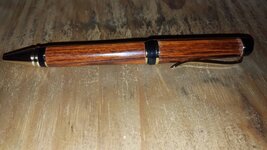ChewTerr
Member
I'm still really novice at this, but I wanted to give CA finish a shot. This is both my first cigar pen as well as my first CA finish. It's a little messy (like at the far right, near the cap/clip), but it's a start. Went through a surprising amount of CA in making the pen, though.
I kind of did it trial and error style. I did a couple of coats of thin, sanded if I saw white mess, and repeated. Eventually I wet-micromeshed into oblivion. Anything I should try next time to improve things? Is it worth experimenting with activator when the thin CA dries so quickly?
I was really nervous to post this. Everybody else's pens look so professional, even people who are only posting their first pens! Also, I wasn't sure this shouldn't be in the finishing forum, since I fished for advice on CA.
I kind of did it trial and error style. I did a couple of coats of thin, sanded if I saw white mess, and repeated. Eventually I wet-micromeshed into oblivion. Anything I should try next time to improve things? Is it worth experimenting with activator when the thin CA dries so quickly?
I was really nervous to post this. Everybody else's pens look so professional, even people who are only posting their first pens! Also, I wasn't sure this shouldn't be in the finishing forum, since I fished for advice on CA.

